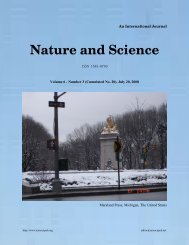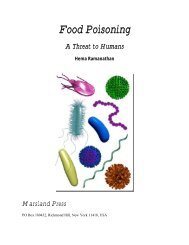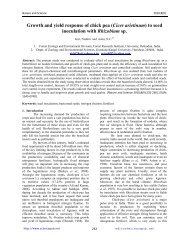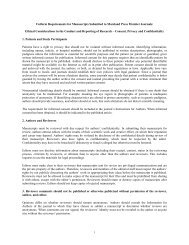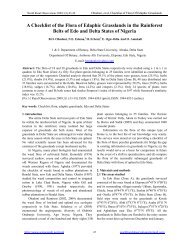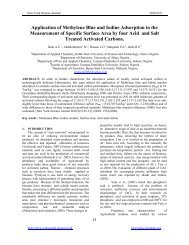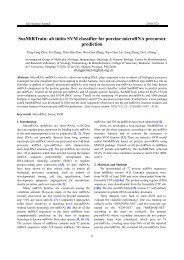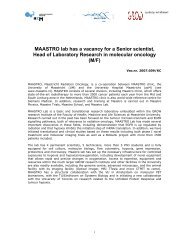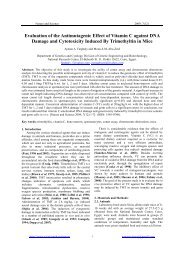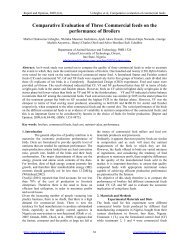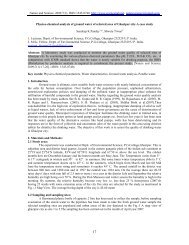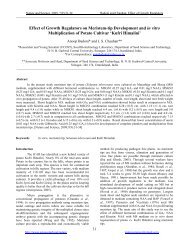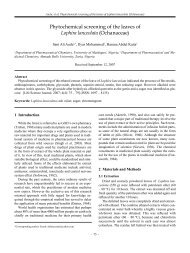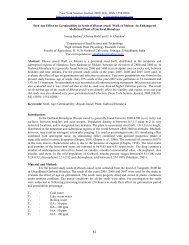Ecological, Social and Commercial Role of Lichens in India with ...
Ecological, Social and Commercial Role of Lichens in India with ...
Ecological, Social and Commercial Role of Lichens in India with ...
You also want an ePaper? Increase the reach of your titles
YUMPU automatically turns print PDFs into web optimized ePapers that Google loves.
Acdemia Arena 2010, Supplement 0201<br />
http://www.sciencepub.net<br />
<strong>Lichens</strong> have ability to resist extremes <strong>of</strong> climatic conditions rang<strong>in</strong>g from low tide sea<br />
shores to the tops <strong>of</strong> the mounta<strong>in</strong>s <strong>and</strong> from arctic to tropical regions, dom<strong>in</strong>at<strong>in</strong>g as much as 8%<br />
<strong>of</strong> the earth’s surface (Ahmadjian 1993; 1995) <strong>and</strong> are amongst the most significant <strong>in</strong>dicators <strong>of</strong><br />
air pollution <strong>and</strong> ecosystem health (Richardson 1992) <strong>and</strong>, besides hav<strong>in</strong>g many economic<br />
medic<strong>in</strong>al applications. They are very sensitive to microclimatic changes. Therefore any natural<br />
manmade disturbances are bound to affect lichen populations. Requisite moisture <strong>and</strong> light,<br />
unpolluted air <strong>and</strong> undisturbed substratum <strong>of</strong>ten favour optimum growth <strong>and</strong> abundance <strong>of</strong> lichens.<br />
<strong>Lichens</strong> arbitrarily classified <strong>in</strong>to three to seven growth forms that do not reflect how the lichens<br />
are related to each other. Different species <strong>with</strong><strong>in</strong> a genus may have different growth forms viz 1.<br />
Crustose, 2. Foliose, 3. Fruticose <strong>and</strong> 4. Squamulose. Crustose lichens form crusts that are so<br />
tightly attached to the rocks, trees, side walls or soils they grow on that they cannot remove <strong>with</strong>out<br />
damag<strong>in</strong>g the substrate. Cracked crusts like the species <strong>of</strong> Acarospora that are separated <strong>in</strong>to<br />
segments (areoles) are called areolate. Crustose lichens, that grows immersed <strong>in</strong> rocks only their<br />
fruit<strong>in</strong>g bodies above the surface are called endolithic, <strong>and</strong> those that grow immersed <strong>in</strong> plant<br />
tissues are called endophloidic or endophlodal. Loose, powdery lichen crusts <strong>with</strong>out a layered<br />
structure called leprose lichens. Foliose lichens are somewhat leaf-like, composed <strong>of</strong> lobes. They<br />
are relatively loosely attached to their substrates, usually by means rhiz<strong>in</strong>es. Their lobes have upper<br />
<strong>and</strong> lower sides <strong>and</strong> usually grow more or less parallel to the substrate viz. Lobaria. Fruticose<br />
lichens are usually round <strong>in</strong> cross section <strong>and</strong> most are branched. They can like little shrubs<br />
grow<strong>in</strong>g upward, or they can hang down <strong>in</strong> long str<strong>and</strong>s viz. Usnea longissima.<br />
<strong>Lichens</strong> <strong>in</strong> <strong>India</strong>n Languages<br />
In <strong>India</strong>n context, the Sanskrit synonyms <strong>of</strong> lichens are ‘Shailaya’ <strong>and</strong> ‘Shila Pushp’ mean<strong>in</strong>g<br />
Shila=rock Pushp=flower. Lichen species are commonly known ‘Stone flower’ <strong>in</strong> English, ‘Pathar<br />
Ka Phul’ <strong>in</strong> H<strong>in</strong>di, ‘Dagad Phul’ <strong>in</strong> Marathi, ‘Kalahu’ <strong>in</strong> Kanada, ‘Kalpasi’ <strong>in</strong> Tamil, <strong>and</strong><br />
‘Rihamkarmani’ <strong>in</strong> Urdu. Locally <strong>in</strong> Garhwal it is known as ‘Mukku’, ‘Shewal’, ‘Jhoola’;<br />
‘Chaarila’ <strong>in</strong> Kumaun; ‘Chaai’ <strong>and</strong> ‘Mendi’ <strong>in</strong> Himanchal. In H<strong>in</strong>di the lichens are also known as<br />
‘Shaik’ (mean<strong>in</strong>g Shai= Shewal <strong>and</strong> K= Kawak).<br />
<strong>India</strong> ranks amongst one <strong>of</strong> the twelve-mega-biodiversity countries <strong>of</strong> the world. The<br />
<strong>in</strong>numerable life forms from unicellular to multicellular <strong>and</strong> microscopic to gigantic harboured <strong>in</strong><br />
the forests, deserts, mounta<strong>in</strong>s, other l<strong>and</strong> forms <strong>and</strong> air <strong>and</strong> water. They are source <strong>of</strong> food, fuel,<br />
cloth<strong>in</strong>g <strong>and</strong> various others our daily needs <strong>and</strong> raw material for <strong>in</strong>dustries.<br />
14



